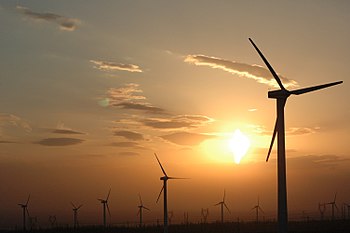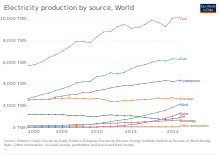
Back Windenergie Afrikaans Enerchía eolica AN طاقة الرياح Arabic বতাহ শক্তি Assamese Enerxía eólico AST Külək enerjisi Azerbaijani Windenagie BAR Viejė energėjė BAT-SMG Kusog nin duros BCL Энергія ветру Byelorussian


| Part of a series on |
| Sustainable energy |
|---|
 |
Wind power is the use of wind energy to generate useful work. Historically, wind power was used by sails, windmills and windpumps, but today it is mostly used to generate electricity. This article deals only with wind power for electricity generation. Today, wind power is generated almost completely with wind turbines, generally grouped into wind farms and connected to the electrical grid.
In 2022, wind supplied over 2,304 TWh of electricity, which was 7.8% of world electricity.[1] With about 100 GW added during 2021, mostly in China and the United States, global installed wind power capacity exceeded 800 GW.[2][3][4] 32 countries generated more than a tenth of their electricity from wind power in 2023 and wind generation has nearly tripled since 2015.[1] To help meet the Paris Agreement goals to limit climate change, analysts say it should expand much faster – by over 1% of electricity generation per year.[5]
Wind power is considered a sustainable, renewable energy source, and has a much smaller impact on the environment compared to burning fossil fuels. Wind power is variable, so it needs energy storage or other dispatchable generation energy sources to attain a reliable supply of electricity. Land-based (onshore) wind farms have a greater visual impact on the landscape than most other power stations per energy produced.[6][7] Wind farms sited offshore have less visual impact and have higher capacity factors, although they are generally more expensive.[2] Offshore wind power currently has a share of about 10% of new installations.[8]
Wind power is one of the lowest-cost electricity sources per unit of energy produced. In many locations, new onshore wind farms are cheaper than new coal or gas plants.[9]
Regions in the higher northern and southern latitudes have the highest potential for wind power.[10] In most regions, wind power generation is higher in nighttime, and in winter when solar power output is low. For this reason, combinations of wind and solar power are suitable in many countries.[11]
- ^ a b "Global Electricity Review 2024". Ember. 7 May 2024. Retrieved 2 September 2024.
- ^ a b "Wind Power – Analysis". IEA. Archived from the original on 23 November 2021. Retrieved 23 November 2021.
- ^ "Wind energy generation vs. installed capacity". Our World in Data. Archived from the original on 19 October 2021. Retrieved 23 November 2021.
- ^ "Global wind industry breezes into new record". Energy Live News. 25 March 2022. Retrieved 2 April 2022.
- ^ "Expansion of wind and solar power too slow to stop climate change". ScienceDaily. Retrieved 24 November 2021.
- ^ "What are the pros and cons of onshore wind energy?". Grantham Research Institute on Climate Change and the Environment, London School of Economics and Political Science. 12 January 2018. Archived from the original on 22 June 2019.
- ^ Jones, Nathan F.; Pejchar, Liba; Kiesecker, Joseph M. (22 January 2015). "The Energy Footprint: How Oil, Natural Gas, and Wind Energy Affect Land for Biodiversity and the Flow of Ecosystem Services". BioScience. 65 (3): 290–301. doi:10.1093/biosci/biu224. ISSN 0006-3568. Retrieved 9 November 2022.
- ^ "Global Wind Report 2019". Global Wind Energy Council. 19 March 2020. Retrieved 28 March 2020.
- ^ Cite error: The named reference
:6was invoked but never defined (see the help page). - ^ "Global Wind Atlas". DTU Technical University of Denmark. Archived from the original on 24 February 2020. Retrieved 28 March 2020.
- ^ Nyenah, Emmanuel; Sterl, Sebastian; Thiery, Wim (1 May 2022). "Pieces of a puzzle: solar-wind power synergies on seasonal and diurnal timescales tend to be excellent worldwide". Environmental Research Communications. 4 (5): 055011. Bibcode:2022ERCom...4e5011N. doi:10.1088/2515-7620/ac71fb. ISSN 2515-7620. S2CID 249227821.